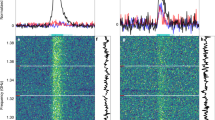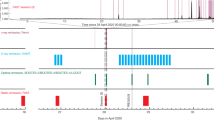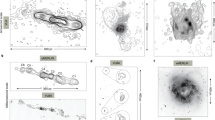Abstract
The radio source 1413 + 135 is shown to be one of the strongest known emitters of millimetre radiation. The energy distribution of this object measured between metre and X-ray wavelengths reveals that most of the power emitted by this object comes out at millimetre and far-IR wavelengths. If the emission at 1 mm is due to incoherent synchrotron radiation, then the source must be very compact, with a size around 25 µ arc s, and contain a magnetic field larger than 10 G. The steep spectral index in the near-IR is attributed to a high-energy cutoff in the distribution of synchrotron emitting electrons at a Lorentz factor γ ∼ 300.
This is a preview of subscription content, access via your institution
Access options
Subscribe to this journal
Receive 51 print issues and online access
$199.00 per year
only $3.90 per issue
Buy this article
- Purchase on Springer Link
- Instant access to full article PDF
Prices may be subject to local taxes which are calculated during checkout
Similar content being viewed by others
References
Condon, J., Hicks, P. D. & Jauncey, D. L. Astr. J., 82, 692 (1977).
Dixon, R. S. Astrophys. J. Suppl. 20, 1 (1970).
Rieke, G. H., Lebofsky, M. J. & Kinman, T. D. Astrophys. J. Lett. 232, L151 (1979).
Beichman, C. A. et al. Astrophys. J. 247, 780 (1981).
Ennis, D. J. thesis, California Institute of Technology (1981).
Hauser, M. G. & Notarys, H. A. Bull. Am. astr. Soc. 7, 409 (1975).
Winston, R. J. opt. Soc. Am. 60, 245 (1970).
Westphal, J. A. Infrared Sky Noise Survey Final Rep. (NASA, Washington DC, 1974).
Werner, M. W., Neugebauer, G., Houck, J. R. & Hauser, M. G. Icarus 35, 289 (1978).
Elias, J. H. et al. Astrophys. J. 220, 25 (1978).
Phillips, T. G., Woody, D., Dolan, G., Miller, R. E. & Linke, R. A. IEEE Trans. Magn. 17, 684 (1981).
Ulich, B. L., Davis, J. H., Rhodes, P. J. & Hollis, J. M. IEEE Trans. Antennae and Propagation, AP28,3,367 (1980).
Harvey, P. M. Publ. astr. Soc. Pacif. 91, 143 (1979).
Bregman, J. N. et al. Nature (this issue).
Schnopper, H. W. et al. Astrophys. J. 222, L91 (1978).
Rieke, G. H. & Lebofsky, M. J. Astrophys. J. 227, 710 (1979).
Jones, T. W. et al. Astrophys. J. 243, 97 (1981).
Ennis, D. J., Neugebauer, G., Soifer, B. T. & Werner, M. W. Astrophys. J. (submitted).
Ginzburg, V. L. & Syrovatsky, S. I. The Origin of Cosmic Rays (Macmillan, New York, 1964).
Rybicki, G. B. & Lightman, A. P. Radiative Processes in Astrophysics (Wiley, New York, 1979).
Jones, T. W., O'Dell, S. L. & Stein, W. A. Astrophys. J. 192, 261 (1974).
O'Dell, S. L. Active Galactic Nuclei, 95 (eds Hazard, C. & Mitton, S.) (Cambridge University Press, 1979).
Rees, M. J. Mon. Not. R. astr. Soc. 135, 345 (1967).
Author information
Authors and Affiliations
Rights and permissions
About this article
Cite this article
Beichman, C., Neugebauer, G., Soifer, B. et al. Compact radio source 1413 + 135 is a far-IR extragalactic object. Nature 293, 711–713 (1981). https://doi.org/10.1038/293711a0
Received:
Accepted:
Issue Date:
DOI: https://doi.org/10.1038/293711a0
This article is cited by
-
Continuum radiation from active galactic nuclei
The Astronomy and Astrophysics Review (1990)
-
Identifications and spectra of extragalactic radio sources
Journal of Astrophysics and Astronomy (1984)
-
The active radio galaxy 1413+135
Nature (1982)
-
Discovery of a very red nucleus in the radio elliptical IC5063 (PKS2048 – 57)
Nature (1982)
Comments
By submitting a comment you agree to abide by our Terms and Community Guidelines. If you find something abusive or that does not comply with our terms or guidelines please flag it as inappropriate.



